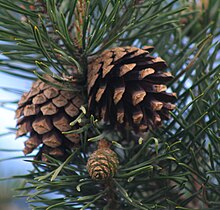

Heterospory is the production of spores of two different sizes and sexes by the sporophytes of land plants. The smaller of these, the microspore, is male and the larger megaspore is female. Heterospory evolved during the Devonian period from isospory independently in several plant groups: the clubmosses, the ferns including the arborescent horsetails,[1] and progymnosperms.[1][2] This occurred as part of the process of evolution of the timing of sex differentiation.[3] Four extant groups of plants are heterosporous; Selaginella, Isoetes, Salviniales and seed plants.[4][5]
- ^ a b Stewart, W.N.; Rothwell, G.W. (1993). Paleobotany and the evolution of plants (2nd ed.). Cambridge: Cambridge University Press. ISBN 978-0-521-38294-6.
- ^ Bateman, R.M.; Dimichele, W.A. (1994). "Heterospory - the most iterative key innovation in the evolutionary history of the plant kingdom" (PDF). Biological Reviews of the Cambridge Philosophical Society. 69 (3): 345–417. doi:10.1111/j.1469-185x.1994.tb01276.x. S2CID 29709953. Archived from the original (PDF) on 2012-04-15. Retrieved 2010-12-30.
- ^ Sussex, I.M. (1966) The origin and development of heterospory in vascular plants. Chapter 9 in Trends in Plant morphogenesis, ed. by E.G. Cutter, Longmans.
- ^ Fern Ecology
- ^ Ancient noeggerathialean reveals the seed plant sister group diversified alongside the primary seed plant radiation